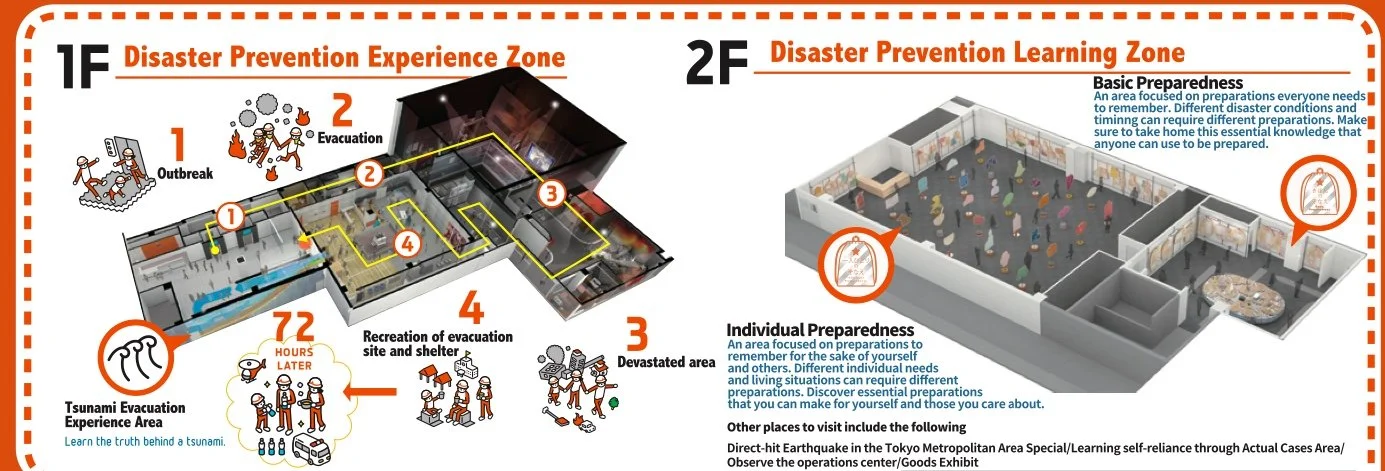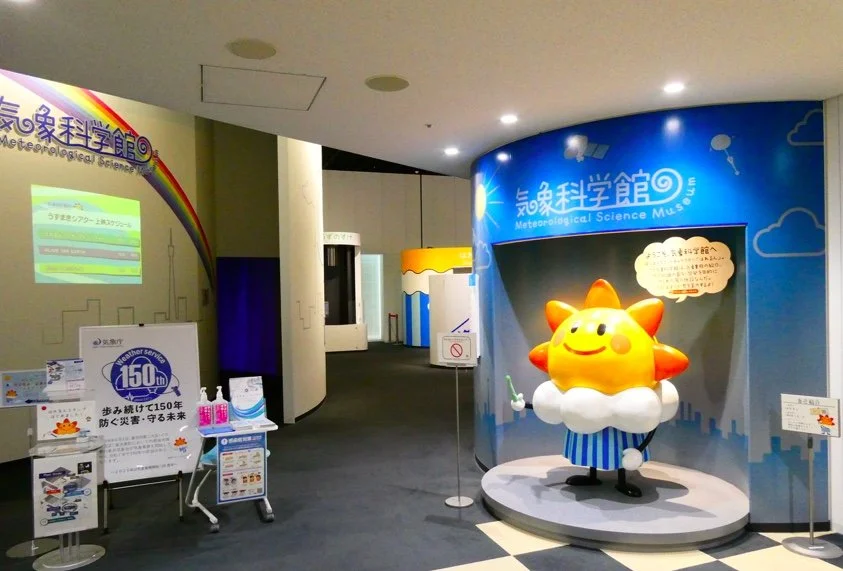Better Than Fear: Experiencing a Seismic 7 Earthquake Simulation in Tokyo
Earthquakes are one of the major risks of living in Japan. Experts warn there is an 80% chance of a large Nankai Trough earthquake within the next 30 years. For those who grew up abroad and have never felt a strong quake, the thought alone can be terrifying.
I’ve always believed it’s better to understand than to fear. Curiosity led me to the Tokyo Fire Department’s Disaster Prevention Hall (Honjo Bosai-kan), where visitors can actually experience a seismic intensity 7 earthquake. I’m so glad I went through it, and I’ll share why—along with the lessons I learned.
In addition, September 1 is Disaster Prevention Day in Japan, a good reminder to think about how we prepare for emergencies.
This blog covers:
1. An overview of the disaster prevention program
2. A dramatic film on the Great Kanto Earthquake
3. Evacuation through a smoke-filled hallway
4. Experiencing a seismic 7 quake firsthand
5. Practical Lessons I Took Home
6. More places to learn
7. Wrap up
Tokyo Fire Department’s Disaster Prevention Hall (Honjo Bosai-kan)
1.An overview of the disaster prevention program
📍 Venue: Tokyo Fire Department’s Disaster Prevention Hall (Honjo Bosai-kan)
🚆 Location: About a 10-minute walk from Kinshicho Station in Sumida Ward, Tokyo
💰 Fee: Free for everyone
🕐 Course Length: 1 hour (reservation required)
The one-hour “Hands-On Survival Course” includes:
A 20-minute film about the Great Kanto Earthquake of 1923.
An evacuation drill in a smoke-filled maze.
A seismic 7 earthquake simulation.
There is also a longer 1-hour 40-minute course, which adds fire extinguisher training and an exercise on how to escape from a car submerged in water.
What surprised me most was the crowd: of about 20 participants, only four were Japanese. Most were foreigners, some with children in tow. The movie had English subtitles, but the facilitator spoke Japanese — a young woman kindly translated for the group. I later discovered that the facility is highly rated on a travel site among international visitors. Clearly, word has spread that this is a must-visit place to gain real survival skills.
2. A dramatic film on the Great Kanto Earthquake
The program began with a 20-minute movie based on the memoir of a real survivor of the Great Kanto Earthquake. The quake struck just before noon on September 1, 1923, when most households were preparing lunch. Fires spread instantly, and more than 100,000 people lost their lives.
The film followed one family living near the very site of the disaster prevention hall. A husband rushed back home to retrieve something but never returned.
The lesson is clear: don’t go back - focus on survival. In the chaos of fire and earthquake, our instinct may be to retrieve valuables or check on our home, but no object is worth a human life.
The film was well made and emotionally powerful.
3.Evacuation through a smoke-filled hallway
Next came the smoke evacuation drill. Our group was divided into three teams and guided into a maze filled with artificial smoke. We crouched low and felt along the walls to find our way out.
The facilitator explained that in a real fire, smoke rises rapidly, making higher floors more dangerous. Most fire victims, in fact, die from smoke inhalation rather than flames.
In a controlled simulation, we all made it through. But I couldn’t help thinking: In a real emergency, could I stay calm enough to make the right decisions? Panic can be just as fatal as smoke.
4.Experiencing a seismic 7 quake firsthand
Finally came the main event: the seismic intensity 7 earthquake simulation. Children were given a milder seismic 5–6 experience, while adults faced the full seismic 7 — equivalent to the Great Kanto Earthquake.
The room was a wide, bare floor with yoga mats. I had expected desks or furniture to crawl under, but instead we were told to sit on the floor, cover our heads, and brace ourselves.
The tremor started gently, then escalated into violent, rolling motion that lasted about 30 seconds. Sound effects and visuals on the screen simulated collapsing surroundings.
Standing was impossible. But sitting low, covering my head, and gripping the mat kept me steady. We went through the experience twice, with a short break in between. By the end, I felt slightly seasick. That’s how powerful seismic 7 is.
And yet — in the simulation, sitting low and protecting our heads kept us unharmed. The shaking itself was frightening, but the real lessons became clear:
I gained better understanding. Experiencing seismic 7 firsthand didn’t fully erase the fear, but it gave me a sense of what to expect and left me feeling a bit more prepared.
The true danger is in the aftermath. Collapsing buildings, falling furniture, fires, and tsunamis often cause more harm than the shaking itself.
✅Magnitude vs. Seismic Intensity — What’s the Difference?
Many foreigners confuse magnitude (the size of the quake itself) with seismic intensity (how strong the shaking feels where you are).
Think of it this way: magnitude = the earthquake’s size, seismic intensity = how much it shakes where YOU are.
5.Practical Lessons I Took Home
✅ Top 3 Causes of Death in Major Earthquakes
🏚️ Building collapse and falling objects – The leading cause in the 1995 Hanshin-Awaji (Kobe) Earthquake, where about 80% of victims died from crushed homes or furniture.
🔥 Fire and smoke inhalation – The primary killer in the 1923 Great Kanto Earthquake, when lunchtime cooking fires spread uncontrollably.
🌊 Tsunami – The overwhelming cause of death in the 2011 Great East Japan Earthquake, where over 90% of victims drowned.
✅Here are some of my key takeaways:
Where you live makes a big difference in how you experience an earthquake. A crowded metropolitan area, a seaside town, or the countryside each comes with different risks.
If you have the option, start by choosing a quake-resistant house or apartment. And think about location: some prefectures experience fewer earthquakes, inland areas carry less tsunami risk and non-crowded area.
Once you combine these choices with the basic preparations we’ve covered, you’ll feel a much greater sense of safety.
6.More Places to Learn
The Honjo Disaster Prevention Hall is an excellent place to start. But Tokyo offers several other unique facilities where you can deepen your preparedness:
✅Sona Area Tokyo (Tokyo Rinkai Disaster Prevention Park)
Picture from the official site
Located in Odaiba, this facility takes a different approach from Honjo. Instead of focusing only on the quake itself, it guides visitors through a 72-hour survival scenario after a major earthquake.
You walk through a life-size disaster zone, face survival choices, and learn how to ration food and water. It’s interactive and especially valuable for families or anyone curious about what happens after the shaking stops.
👉 Official Website
✅Meteorological Science Museum (気象科学館)
Picture from the official site
Operated by the Japan Meteorological Agency, this museum covers natural phenomena like weather, typhoons, and volcanoes. Among its highlights are disaster-preparedness exhibits:
Disaster Point Watcher: An interactive quiz that teaches how to protect yourself during earthquakes, tsunamis, typhoons, and sudden heavy rain. It helps you notice things you might otherwise overlook.
Emergency Earthquake Alert Trial: Many people panic at the sudden alarm sound of early-warning systems. Here, you can safely experience how the alerts work and practice the right actions, so you’ll feel calmer when you hear one in real life.
Both facilities offer a broader perspective on disaster readiness — from immediate survival during shaking, to coping in the days that follow, and even responding to Japan’s other natural threats.
7.Wrap up
In Japan, there’s a saying: 備えあれば憂いなし (Sonae areba urei nashi) — “If you are prepared, you need not worry.” Of course, even with preparation, some worry never completely disappears. But readiness is the key.
If you live in Japan, or you are even a traveler, I strongly encourage you to visit a disaster prevention center. Feel the simulation. Try the smoke maze. Walk through the survival scenarios. Learn how to protect yourself and your loved ones.
Because in the end, preparedness isn’t just about survival — it’s about peace of mind.
👉 Related reading: Earthquake Survival in Japan: Tips, Tools, and What to Expect







